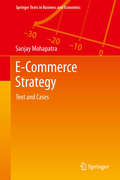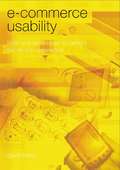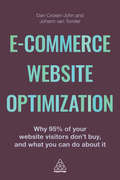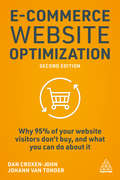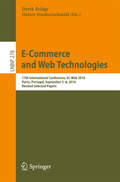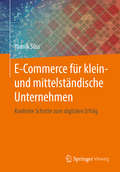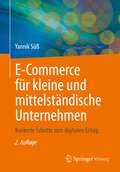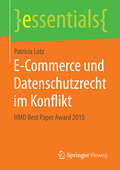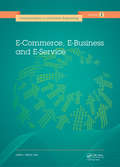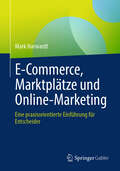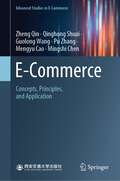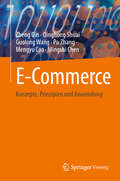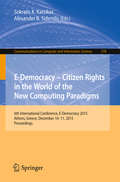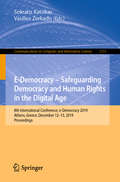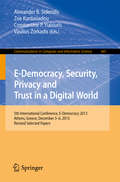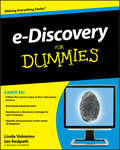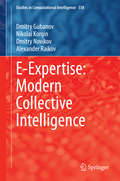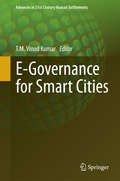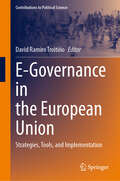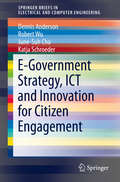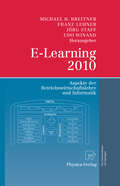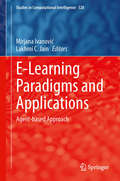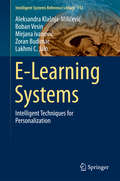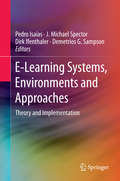- Table View
- List View
E-Commerce Strategy
by Sanjay MohapatraE-Commerce Strategy: Text and Cases provides the fundamental literature required for graduate students and practitioners to understand electronic commerce. Each chapter provides clearly designed learning objectives and review questions to highlight the major topics and goals. This book covers many of the new innovations and technologies that have been established for e-commerce site development. Unlike similar books, topics such as e-channel adoption, factors affecting e-commerce adoption, and strategy design are reviewed in greater depth. Additionally, the book examines areas not normally covered like open source, online research, and peer-to-peer systems. E-Commerce Strategy: Text and Cases is divided into two parts. Part 1 examines the evolution of e-commerce, analyzes different sectors such as B2B and m-Commerce, and explores the challenges they face. Case studies of well known companies reinforce the concepts learned to demonstrate both successes and failures in the field. Part 2 deals with developing strategies in e-Commerce and looks at future trends including Web 2.0. Overall, the useful guidelines provided should prove valuable to students and researchers in the field.
E-Commerce Usability: Tools and Techniques to Perfect the On-Line Experience
by David TravisTop performing dotcoms share a common feature. It isn't a new software plug-in or a design gadget or any other piece of technology. These sites share a passionate focus on usability. This book is written by an international usability consultant, writer and trainer who specializes in the design and evaluation of web-based and wireless applications,
E-Commerce Website Optimization: Why 95% of Your Website Visitors Don't Buy, and What You Can Do About it
by Dan Croxen-John Johann Van TonderFor those running e-commerce websites there are three ways to increase sales: increasing the quantity of visitors; increasing the percentage of visitors who buy from the site; and increasing the amount that visitors spend when they buy. E-commerce Website Optimization goes beyond simply increasing traffic, helping readers to improve conversion rates, increase ROI from online marketing campaigns, and generate higher levels of repeat business. It brings together usability, analytics and persuasion to offer a straightforward and detailed 5-step methodology of how to use the tools and techniques of Conversion Rate Optimization (CRO) to increase the e-commerce value of websites. Grounded in the latest theory and research, this will help readers to be well-informed and confident to make the right choices.Backed up with a range of invaluable case studies, E-commerce Website Optimization is perfect for those seeking to implement a data-driven ethos to their organization's e-commerce programme, based on market-tested and robust split-test methodology used across a range of commercial businesses. It supports all those responsible for online sales within an organization, be they the Chief Digital Officer, Head of Online Sales or E-commerce; or entrepreneurs and owners of small businesses deriving a substantial proportion of revenue from e-commerce.
E-Commerce Website Optimization: Why 95% of Your Website Visitors Don't Buy, and What You Can Do About it
by Dan Croxen-John Johann van TonderConversion rate optimization (CRO) is a complex field and one that is rapidly evolving. It's about understanding people and their behaviour, not simply website visits. E-commerce Website Optimization provides an all-encompassing guide, explaining the how and why, before focusing on techniques and tools to increase the percentage of visitors who buy from the site, and subsequently the amount that these visitors spend when they buy. Grounded in best-practice theory and research, it brings together usability, analytics and persuasion to offer a detailed, step-by-step guide to improve conversion rates, increase ROI from online marketing campaigns, generate higher levels of repeat business and increase the e-commerce value of websites. In the fast-moving world of e-commerce, this fully revised second edition includes updates on test metrics, prioritization and personalization, as well as a new chapter on persuasive copywriting. Alongside updated case studies and newly recommended tools, E-commerce Website Optimization is an invaluable book for those seeking to implement a data-driven ethos for their organization's e-commerce programme, for everyone from chief digital officers and heads of online sales, to entrepreneurs and small business owners.
E-Commerce and Web Technologies
by Heiner Stuckenschmidt Derek BridgeThis book constitutes revised proceedings of the 17th International Conference on E-Commerce and Web Technologies, EC-Web 2016, held in Porto, Portugal, in September 2016, in conjunction with DEXA. The 13 papers presented in this volume were carefully reviewed and selected from 21 submissions. They were organized in topical sections named: recommender systems; data management and data analysis; and business processes, Web services and cloud computing.
E-Commerce für klein- und mittelständische Unternehmen
by Yannik SüssIn zehn Kapiteln vermittelt dieses Fachbuch den Weg zu einem erfolgreichen Onlineshop. Ausgehend von einem schlüssigen Konzept, über die Auswahl der Technologie und Fragen der Usability sowie rechtliche Aspekte und die praktische Umsetzung werden auch Themen wie Versandabwicklung oder Suchmaschinenoptimierung behandelt. Hierfür wird auf jeden Schritt umfassend eingegangen, um so ein tiefes Bewusstsein für Anforderungen und notwendige Durchführungsschritte zu generieren. Der Autor stellt dabei den neuen Wachstumsmarkt E-Commerce vor.
E-Commerce für kleine und mittelständische Unternehmen: Konkrete Schritte zum digitalen Erfolg
by Yannik SüßIn zehn Kapiteln vermittelt dieses Fachbuch den Weg zu einem Onlineshop und der Autor stellt den Wachstumsmarkt E-Commerce vor.Neben der Entwicklung eines schlüssigen Konzepts, der Auswahl der Technologie, Klärung der Fragen zur Usability und zur Rechtsgrundlage, wird auch die praktische Umsetzung wie Versandabwicklung oder Marketing behandelt. Dabei wird auf jeden Schritt umfassend eingegangen, um so ein tiefes Bewusstsein für Anforderungen und notwendige Durchführungsschritte zu schaffen.
E-Commerce und Datenschutzrecht im Konflikt: HMD Best Paper Award 2015 (essentials)
by Patricia LotzPatricia Lotz behandelt Rechtsfragen zum Einsatz moderner Marketingformen und gibt einen ersten #65533;berblick #65533;ber die Fallstricke, die sich dem E-Commerce in Zukunft vor allem im Bereich des Datenschutzes stellen werden. Die Autorin zeigt gleichzeitig m#65533;gliche L#65533;sungswege auf. Aus rechtlicher Sicht bespricht sie Webtracking, Geolokalisierung und Social Plugins. Zudem gibt sie eine #65533;bersicht #65533;ber die Integration von E-Payment-L#65533;sungen.
E-Commerce, E-Business and E-Service (Communications in Information Engineering)
by Garry LeeThe 2014 International Conference on E-Commerce, E-Business and E-Service (EEE 2014) was held on May 1-2, 2014, Hong Kong. This proceedings volume assembles papers from various professionals, leading researchers, engineers, scientists and students and presents innovative ideas and research results focused on the progress of E-Commerce, E-Business a
E-Commerce, Marktplätze und Online-Marketing: Eine praxisorientierte Einführung für Entscheider
by Mark HarwardtDas Buch zeigt die dynamischen und vielschichtigen Welten des E-Commerce, der elektronischen Marktplätze und des Online-Marketings auf - Themen, die in unserer zunehmend digitalisierten Welt von zentraler Bedeutung sind. Denn E-Commerce hat sich von einem Nischenmarkt zu einem globalen Phänomen entwickelt, das die Art und Weise, wie wir kaufen und verkaufen, grundlegend verändert hat. Der Autor stellt die theoretischen Aspekte von E-Business, E-Commerce, Marktplätzen, Online-Marketing sowie die rechtlichen Rahmenbedingungen vor und gibt insbesondere Einblicke in die Praxis. Das Ziel dieses Buches ist es die grundlegenden Begriffe und Zusammenhänge von E-Commerce und Online-Marketing zu erklären, sodass die gewonnenen Erkenntnisse direkt in die berufliche Praxis integriert werden können.
E-Commerce: Concepts, Principles, and Application (Advanced Studies in E-Commerce)
by Zheng Qin Guolong Wang Qinghong Shuai Pu Zhang Mengyu Cao Mingshi ChenThis book mainly discusses the background of e-commerce, the basic knowledge of e-commerce, the basic models of e-commerce, the basic principles of e-commerce and the cases of e-commerce. This book has formed a theoretical system of e-commerce with a clear integration boundary. The introduction of the systematic theory is guided by the background of e-commerce, centered on the model of e-commerce, paved with the principles of e-commerce and integrated with the cutting-edge cases. This book defines the basic concepts, models and principle of e-commerce in the form of mathematical analysis and analyzes the basic theory of e-commerce from the perspective of mathematical model. This enables readers to form an abstract understanding of the connotation and extension of e-commerce. It establishes a knowledge system with the background of social ecology, engineering ecology and innovative ecology, taking the models of e-commerce as the core, the principles of e-commerce as the process, the architecture of e-commerce as the platform and the operation and management of e-commerce as the means to integrate the knowledge into application. This book uses case study to comprehensively analyze and apply the knowledge system involved in e-commerce, combining theoretical research with engineering research. Through this book, readers can systematically master all kinds of theories involved in e-commerce. This book aims at different professional and diverse reader groups. It can be used as the basic books for students of various e-commerce-related specialties.
E-Commerce: Konzepte, Prinzipien und Anwendung
by Zheng Qin Guolong Wang Qinghong Shuai Pu Zhang Mengyu Cao Mingshi ChenDieses Buch behandelt hauptsächlich den Hintergrund des E-Commerce, das Grundwissen des E-Commerce, die Grundmodelle des E-Commerce, die Grundprinzipien des E-Commerce und die Fälle des E-Commerce. Dieses Buch hat ein theoretisches System des E-Commerce mit klaren Integrationsgrenzen gebildet. Die Einführung der systematischen Theorie wird durch den Hintergrund des E-Commerce geleitet, zentriert sich auf das Modell des E-Commerce, wird mit den Prinzipien des E-Commerce untermauert und mit den neuesten Fällen integriert. Dieses Buch definiert die grundlegenden Konzepte, Modelle und Prinzipien des E-Commerce in Form einer mathematischen Analyse und analysiert die Grundtheorie des E-Commerce aus der Perspektive des mathematischen Modells. Dies ermöglicht den Lesern, ein abstraktes Verständnis der Konnotation und Erweiterung des E-Commerce zu entwickeln. Es etabliert ein Wissenssystem mit dem Hintergrund der sozialen Ökologie, der Ingenieurökologie und der Innovationsökologie, wobei die Modelle des E-Commerce als Kern, die Prinzipien des E-Commerce als Prozess, die Architektur des E-Commerce als Plattform und der Betrieb und das Management des E-Commerce als Mittel zur Integration des Wissens in die Anwendung dienen. Dieses Buch verwendet Fallstudien, um das Wissenssystem, das den E-Commerce betrifft, umfassend zu analysieren und anzuwenden und kombiniert theoretische Forschung mit Ingenieurforschung. Durch dieses Buch können die Leser systematisch alle Arten von Theorien, die den E-Commerce betreffen, meistern. Dieses Buch richtet sich an verschiedene professionelle und diverse Lesergruppen. Es kann als Grundlagenbuch für Studenten verschiedener E-Commerce-bezogener Fachrichtungen verwendet werden.
E-Democracy - Citizen Rights in the World of the New Computing Paradigms
by Sokratis K. Katsikas Alexander B. SideridisThis book constitutes the refereed proceedings of the 6thInternational Conference on E-Democracy, E-Democracy 2015, held in Athens,Greece, in December 2015. The 13 revised full paperspresented together with 8 extended abstracts were carefully selected from 33submissions. The papers are organized in topical sections on privacy ine-voting, e-polls and e-surveys; security and privacy in new computingparadigms; privacy in online social networks; e-government ande-participation; legal issues. The book also contains the extendedabstracts describing progress within European research and development projectson security and privacy in the cloud; secure architectures andapplications; enabling citizen-to-government communication.
E-Democracy – Safeguarding Democracy and Human Rights in the Digital Age: 8th International Conference, e-Democracy 2019, Athens, Greece, December 12-13, 2019, Proceedings (Communications in Computer and Information Science #1111)
by Sokratis Katsikas Vasilios ZorkadisThis book constitutes the refereed proceedings of the 8th International Conference on E-Democracy, E-Democracy 2019, held in Athens, Greece, in December 2019.The 15 revised full papers presented were carefully selected from 27 submissions. The papers are organized in topical sections on rrivacy and data protection; e-government; e-voting and forensics; online social networks and "fake news".
E-Democracy, Security, Privacy and Trust in a Digital World: 5th International Conference, E-Democracy 2013, Athens, Greece, December 5-6, 2013, Revised Selected Papers (Communications in Computer and Information Science #441)
by Alexander B. Sideridis, Zoe Kardasiadou, Constantine P. Yialouris and Vasilios ZorkadisThis book constitutes the thoroughly refereed post-conference proceedings of the 5th International Conference on Security, Privacy and Trust in a Digital World, e-Democracy 2013, held in Athens, Greece, December 2013. The 20 revised full papers presented were carefully selected from numerous submissions. The papers are organized in topical sections on security, privacy; e-governance; e-government applications, virtualizations; politics, legislation: European initiatives.
E-Discovery for Dummies
by Linda Volonino Ian RedpathDiscover the process of e-discovery and put good practices in place. Electronic information involved in a lawsuit requires a completely different process for management and archiving than paper information. With the recent change to Federal Rules of Civil Procedure making all lawsuits subject to e-discovery as soon as they are filed, it is more important than ever to make sure that good e-discovery practices are in place. e-Discovery For Dummies is an ideal beginner resource for anyone looking to understand the rules and implications of e-discovery policy and procedures. This helpful guide introduces you to all the most important information for incorporating legal, technical, and judicial issues when dealing with the e-discovery process. You'll learn the various risks and best practices for a company that is facing litigation and you'll see how to develop an e-discovery strategy if a company does not already have one in place. E-discovery is the process by which electronically stored information sought, located, secured, preserved, searched, filtered, authenticated, and produced with the intent of using it as evidence Addresses the rules and process of e-discovery and the implications of not having good e-discovery practices in place Explains how to develop an e-discovery strategy if a company does not have one in place e-Discovery For Dummies will help you discover the process and best practices of managing electronic information for lawsuits.
E-Expertise: Modern Collective Intelligence
by Dmitry Gubanov Nikolai Korgin Dmitry Novikov Alexander RaikovThis book focuses on organization and mechanisms of expert decision-making support using modern information and communication technologies, as well as information analysis and collective intelligence technologies (electronic expertise or simply e-expertise). Chapter 1 (E-Expertise) discusses the role of e-expertise in decision-making processes. The procedures of e-expertise are classified, their benefits and shortcomings are identified and the efficiency conditions are considered. Chapter 2 (Expert Technologies and Principles) provides a comprehensive overview of modern expert technologies. A special emphasis is placed on the specifics of e-expertise. Moreover, the authors study the feasibility and reasonability of employing well-known methods and approaches in e-expertise. Chapter 3 (E-Expertise: Organization and Technologies) describes some examples of up-to-date technologies to perform e-expertise. Chapter 4 (Trust Networks and Competence Networks) deals with the problems of expert finding and grouping by information and communication technologies. Chapter 5 (Active Expertise) treats the problem of expertise stability against any strategic manipulation by experts or coordinators pursuing individual goals. The book addresses a wide range of readers interested in management, decision-making and expert activity in political, economic, social and industrial spheres.
E-FOOD: Closing the Online Enforcement Gap in the EU Platform Economy (Studies in European Economic Law and Regulation #21)
by Maria Jose Plana CasadoRetail is ‘going digital,’ and grocery shopping is no exception. While some businesses are relaying on their corporate website to make the sale, both traditional brick-and-mortar and new disruptive business models are increasingly using online marketplaces to offer their products online. European Union law has been gradually updated to reflect this new reality, with Intellectual Property Rights legislation and Consumer Law leading the way toward a suitable regulatory framework in the Platform Economy. However, the EU has not devised a comprehensive strategy for tackling the challenges posed by the online sale of physical consumer goods, such as effective public enforcement in online environments. In fact, sector-specific legislation, including Food Law, largely ignores online transactions. In this context, the book evaluates the impact that online marketplaces are having on European Union sector-specific legislation and its e-nforcement. The goal is to assess whether the existing regulatory and policy framework are sufficient for promoting compliance and bridging the enforcement gap in the digital single market. Focusing on the e-food market, the book presents a state-of-the-art overview of how online marketplaces are altering EU law and its enforcement by public authorities.
E-Governance for Smart Cities
by T. M. Vinod KumarThis book highlights the electronic governance in a smart city through case studies of cities located in many countries. "E-Government" refers to the use by government agencies of information technologies (such as Wide Area Networks, the Internet, and mobile computing) that have the ability to transform relations with citizens, businesses, and other arms of government. These technologies can serve a variety of different ends: better delivery of government services to citizens, improved interactions with business and industry, citizen empowerment through access to information, or more efficient government management. The resulting benefits are less corruption, increased transparency, greater convenience, revenue growth, and/or cost reductions. The book is divided into three parts. * E-Governance State of the Art Studies of many cities * E-Governance Domains Studies * E-Governance Tools and Issues
E-Governance in the European Union: Strategies, Tools, and Implementation (Contributions to Political Science)
by David Ramiro TroitiñoThis book sheds new light on the future of e-governance in the European Union (EU). Drawing on the first-hand professional experience of practitioners, policymakers, and institutional stakeholders, combined with a sound academic foundation, it offers insights into successful implementation strategies and new tools necessary for efficient e-governance in the European Union. The authors present key topics, e.g. the development of e-services such as e-identity, e-health, e-democracy, as well as e-governance tools for the correct implementation of the Digital Single Market. Furthermore, they discuss the legal framework needed for the implementation of these services, such as data protection, digital competition law, as well as EU contracts in digital environments. Finally, the authors highlight efforts to include ethical standards and European values in the decision-making, while developing a vision for the future use of e-governance in the European Union.Understanding the tools and strategies for a successful implementation of e-governance services, as well as the necessary legal framework, will allow professionals such as policymakers and institutional stakeholders, to improve their performance and achieve better results when working on the development of future e-governance services in the European Union.
E-Government Strategy, ICT and Innovation for Citizen Engagement
by Dennis Anderson Robert Wu June-Suh Cho Katja SchroederThis book discusses three levels of e-government and national strategies to reach a citizen-centric participatory e-government, and examines how disruptive technologies help shape the future of e-government. The authors examine how e-government can facilitate a symbiotic relationship between the government and its citizens. ICTs aid this relationship and promote transparencies so that citizens can place greater trust in the activities of their government. If a government can manage resources more effectively by better understanding the needs of its citizens, it can create a sustainable environment for citizens. Having a national strategy on ICT in government and e-government can significantly reduce government waste, corruption, and inefficiency. Businesses, CIOs and CTOs in the public sector interested in meeting sustainability requirements will find this book useful.
E-Learning 2010
by Franz Lehner Jörg Staff Michael Breitner Udo WinandTechnologiebasiertes und mobiles Lernen und Lehren sind in der Informations- und Wissensgesellschaft von zentraler Bedeutung. Ziel des Sammelbandes ist es, einen Blick in die nahe Zukunft des E- und M-Learnings zu werfen: der lebenslangen Aus- und Weiterbildung vom Vorschul- bis ins Rentenalter unter Verwendung von Rechnern und Rechnernetzwerken. Bei der Entwicklung solcher Angebote kommt es vor allem darauf an, ganzheitliche, integrierte Ansätze zu finden, die die drei Säulen Technologie, Didaktik und Betriebswirtschaftslehre berücksichtigen.
E-Learning Paradigms and Applications
by Lakhmi C. Jain Mirjana IvanovićTeaching and learning paradigms have attracted increased attention especially in the last decade. Immense developments of different ICT technologies and services have paved the way for alternative but effective approaches in educational processes. Many concepts of the agent technology, such as intelligence, autonomy and cooperation, have had a direct positive impact on many of the requests imposed on modern e-learning systems and educational processes. This book presents the state-of-the-art of e-learning and tutoring systems and discusses their capabilities and benefits that stem from integrating software agents. We hope that the presented work will be of a great use to our colleagues and researchers interested in the e-learning and agent technology.
E-Learning Systems
by Lakhmi C. Jain Mirjana Ivanović Aleksandra Klašnja-Milićević Boban Vesin Zoran BudimacThis monograph provides a comprehensive research review of intelligent techniques for personalisation of e-learning systems. Special emphasis is given to intelligent tutoring systems as a particular class of e-learning systems, which support and improve the learning and teaching of domain-specific knowledge. A new approach to perform effective personalization based on Semantic web technologies achieved in a tutoring system is presented. This approach incorporates a recommender system based on collaborative tagging techniques that adapts to the interests and level of students' knowledge. These innovations are important contributions of this monograph. Theoretical models and techniques are illustrated on a real personalised tutoring system for teaching Java programming language. The monograph is directed to, students and researchers interested in the e-learning and personalization techniques.
E-Learning Systems, Environments and Approaches
by Dirk Ifenthaler J. Michael Spector Demetrios G. Sampson Pedro IsaíasThe volume consists of twenty-five chapters selected from among peer-reviewed papers presented at the CELDA (Cognition and Exploratory Learning in the Digital Age) 2013 Conference held in Fort Worth, Texas, USA, in October 2013 and also from world class scholars in e-learning systems, environments and approaches. The following sub-topics are included: Exploratory Learning Technologies (Part I), e-Learning social web design (Part II), Learner communities through e-Learning implementations (Part III), Collaborative and student-centered e-Learning design (Part IV). E-Learning has been, since its initial stages, a synonym for flexibility. While this dynamic nature has mainly been associated with time and space it is safe to argue that currently it embraces other aspects such as the learners' profile, the scope of subjects that can be taught electronically and the technology it employs. New technologies also widen the range of activities and skills developed in e-Learning. Electronic learning environments have evolved past the exclusive delivery of knowledge. Technology has endowed e-Learning with the possibility of remotely fomenting problem solving skills, critical thinking and team work, by investing in information exchange, collaboration, personalisation and community building.
